Delhi’s Extreme Weather: Is Cloud Seeding to Blame for Floods and Property Damage?
As Delhi grapples with the aftermath of extreme weather events, there is an urgent need for more research into the effects of cloud seeding. Many are calling for a thorough investigation into the potential link between cloud seeding and the worsening weather conditions in the city. Understanding the long-term implications of artificial weather modification is crucial to safeguarding the environment and mitigating future risks.
In the past, our country has tried cloud seeding, but only during the monsoon season and to make it rain in specific areas, not to decrease pollution levels.
During the 2024 monsoon season, several states in India implemented cloud seeding programs to boost rainfall and mitigate water stress.
In 2024, the city of Delhi conducted cloud seeding experiments in an attempt to increase rainfall and alleviate water scarcity. However, since then, many residents have started blaming the unusual weather patterns and excessive rainfall on the continued cloud seeding practices. But is there any truth to these claims? Let’s take a closer look at the issue.
Scientists have warned that the repeated use of cloud seeding techniques can disrupt natural weather patterns and lead to unforeseen consequences. The heavy floods and bad weather experienced in Delhi in recent years may be a result of continuous interference with the atmosphere’s delicate balance. Many argue that cloud seeding may provide short-term relief but could have long-term detrimental effects on the environment.
One of the most alarming incidents in Delhi’s recent history was the collapse of an airport building due to the heavy rains and strong winds. The city has been experiencing massive waterlogging, leading to property damage and disruption of daily life for residents.

The residents are attempting to clear the flooded pathways with bucket
Did you notice how the weather in Delhi has been changing recently? It’s like the same kind of changes that happened in Dubai are happening here now.
The debate goes beyond just the scientific validity of cloud seeding. It raises critical questions about control, transparency, and the ethical implications of manipulating weather patterns. Should we be tampering with nature, even with the intent of bringing relief?
Ultimately, the debate over Delhi’s rain highlights the complex relationship between humans and nature. While cloud seeding may offer a temporary solution to water scarcity, it also begs the question of long-term sustainability and potential unintended consequences.
Talking about the rain in Delhi is just the start. It makes us think about weather-changing techology, the good and bad sides, and the ethics of messing with the climate. Cloud seeding isn’t the answer and it’s messing up the environment.
Source: Qvive.in, Twitter Facebook
Also read:
